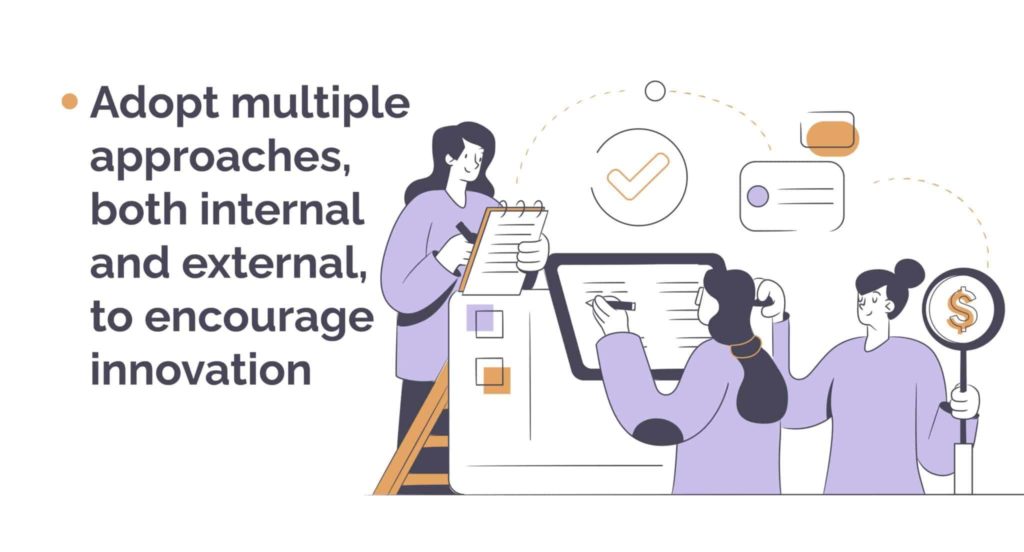The most successful B2B brands don’t “innovate”—they are innovative. In this post, we’re going to explore what it means to be an innovative B2B brand and how your brand can become a market leader through embracing a permanent, holistic approach to innovation.
Let’s get started.
Innovating vs. being innovative
So innovating vs. innovative: That may sound like splitting hairs, but there’s a real difference. Innovating a new product or a method of doing things is an event. Being innovative, on the other hand, means being in a permanent state of evolution—it’s seen in how a brand operates, how leadership leads, and how new ideas are nurtured (or not).
Related post: 3 In-Depth Reasons You Need B2B PR to Become a Thought Leader
While there are many benefits to being an innovative company, from improved staff morale to faster product development, recent data from Bain & Company also shows a huge financial benefit, as well: according to their research, companies with experienced innovators at the help grew their market capitalization at a five-year compound annual rate of 9.5%, while those with the least experienced innovators grew at a rate of just 0.5%.

How do B2B brands establish a culture of permanent innovation?
For those leading companies, innovating on an ongoing basis is central to doing business. Here are 4 strategies these B2B brands use to achieve a state of permanent innovation.
Incorporate a variety of strategies to encourage innovation, not just one
Google’s famous “20-percent rule,” which encourages employees to spend 20 percent of their time working on independent projects that they think would benefit the company, is one of the more famous examples of a company putting innovation into practice.
This is just one strategy, however—and you can bet that Google, one of the world’s most successful innovators, doesn’t rely on this strategy alone.
Neither should your brand.
Instead of embracing one approach to innovation, the most successful brands in Bain’s research used several on an ongoing basis.
These included:
- Corporate venture capital funds and/or business accelerators
- Hackathons, idea competitions, and other dedicated events
- Acquisitions of other companies
- External partnerships
The reason for this can be found in this research by Stanford professor Bob Sutton, which found that in order to launch two or three commercially successful products, a company must start with 4,000 raw ideas.
Let’s repeat that because it matters: 4,000 ideas will typically net a brand two or three successful products.
How can a brand’s staff possibly generate that many new ideas in the midst of completing the many tasks associated with maintaining and improving existing products, managing sales, and ensuring a positive customer experience?
Related post: Why Selling No Longer Works – and What B2B Brands Must Do Instead
They can’t. That’s why creating ongoing opportunities for innovation that are built into a company’s operations and culture is so critical.
Accept a greater degree of risk.
No company can become innovative without accepting a certain degree of risk—usually, a higher degree than most executives are typically comfortable with.
This is true despite the way the broader business culture glorifies risk-takers and those with entrepreneurial mindsets.
While many executives and leaders may say they believe in risk-taking, research cited in the Harvard Business Journal found something quite different.
When presented with a hypothetical investment opportunity, only 9% of managers surveyed would accept the chance if there were a 40% chance of losing. And on average, the greatest chance of loss that managers would accept was 19%.
There’s simply no way for innovation to thrive in an environment this risk-averse. Even if you think your brand isn’t behaving similarly, it’s worth examining your own practices closely to see whether you truly are embracing risk, or avoiding it at all costs.
Ensure you’re not inadvertently discouraging risk-taking.
In order to feel safe experimenting, exploring, and failing—all of which are critical to the process of innovation—everyone from your newest entry-level employee to your most senior manager must know that your brand actively values these activities.
That goes way beyond mission statements and corporate lip service. It takes action on the part of leadership.
What do your department managers do, for example, if an employee brings them a new idea for a product? Do they thank them and then file the idea away, or do they encourage the employee to continue exploring it? Does the idea ever make it up the chain of command, if there’s potential there?
Beyond that, how are you rewarding risk-takers in your company? Are they getting promoted at a faster or slower rate than other employees? Do they receive recognition for their work?
It’s important to examine any potential issues like these that could be quietly discouraging innovation at your company. Additional things to pay attention to include:
- Departmental roadblocks that prevent good ideas from circulating and developing
- Lack of follow-through from managers and supervisors leaves good ideas languishing
- Lack of a structure to support experimentation (i.e. the 20% rule)

Promote your brand’s commitment to innovation through PR and marketing channels
B2B clients want to know that the company they’re working with is a market leader—an innovator in their field.
Related post: The Ultimate Guide To B2B PR
And they can only know that if you share your commitment to innovation openly, through PR placements and your own marketing channels.
Did you host a company hackathon recently? Share photos and information on the winners on social media.
Did an employee come up with a risky idea that contributed to the development of a new product? Highlight that employee in your owned media, and then go further by having your PR firm pitch them to podcasts or trade publications.
Not only will this help expand your audience and establish your reputation as an innovative B2B brand but it will also serve as a kind of accountability check. If you’re touting your commitment to innovation to your clients, followers, and competitors, your leadership is more likely to prioritize it, even when doing so feels difficult.
B2B brands that embrace innovation as an integral mode of operating consistently perform higher than those that don’t. By putting these tactics to work and following through with a strong B2B PR and marketing strategy, your brand can reach frontrunner status—and that’s where things really get interesting.
Need some help crafting that PR and marketing strategy? Give us a call.







